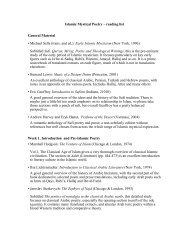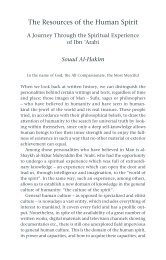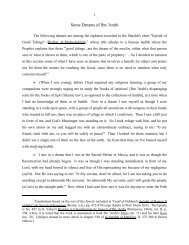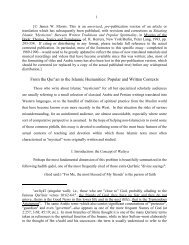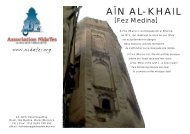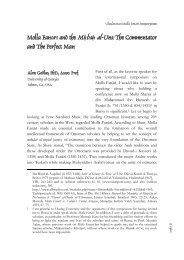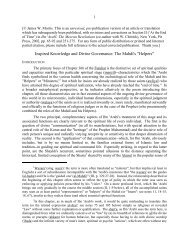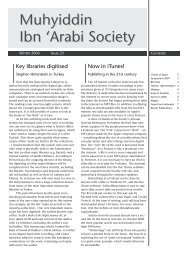Part III (pdf) - Muhyiddin Ibn Arabi Society
Part III (pdf) - Muhyiddin Ibn Arabi Society
Part III (pdf) - Muhyiddin Ibn Arabi Society
You also want an ePaper? Increase the reach of your titles
YUMPU automatically turns print PDFs into web optimized ePapers that Google loves.
31illustrating and illuminating a particular spiritual insight or problem and guiding a moreextended reflection—sometimes didactic, sometimes quite personal and even ecstatic—on itsmetaphysical, moral, or theological implications. The result, at its best, is neither a sermon norformal (even mystical) exegesis, but something much more intimate and direct, namely, thecommunication of what ‘<strong>Ibn</strong> ‘Arabî often calls an ishâra, the ‘allusion’ or inner meaning thatapplies specifically to one’s own immediate spiritual condition. This aspect of the Mawâqif isespecially apparent in the more intimate, autobiographical passages (e.g., sections 1 and 36-37here)—a sort of writing relatively rare in <strong>Arabi</strong>c mystical literature, but revealing the veryessence of the spiritual work and relation between master and disciple—in which ‘Abd al-Qâdirrecounts his own repeated experiences of what he calls (again following <strong>Ibn</strong> ‘Arabî) ‘ilqâ’, thatis, the direct inner awareness of the ‘projection’ into one’s awareness of a passage of the Qur’antogether with the specific meaning uniquely appropriate to one’s spiritual state at that moment. 120The majority of these selections, however, are comparatively more didactic andimpersonal. Often reflecting ‘Abd al-Qâdir’s own teaching activity (including daily lectures inhis later years at Damascus), they all revolve around the central transforming insight into theThe significance of the title is carefully explained at pp 27-28. More important than anyallusion to the work of the same name by the famous early Sufi Niffârî, as M. Chodkiewicznotes, is its characteristic usage by <strong>Ibn</strong> ‘Arabî, for whom mawqif, in the context of the spiritualpath, is the ‘halt’ or ‘stopping’ place between two spiritual stations (manzil or maqâm) where thetraveler (sâlik) receives the guidance or instructions that enable him to realize fully and in detailthe spiritual understanding appropriate to the following station. There is thus a profound innerconnection between the ‘spiritual itinerary’ traced out in detail in these writings and ‘Abd al-Qâdir’s decision (see n. 116 above) to return and retrace in full the different stages required ofmost spiritual wayfarers.120See especially ‘Abd al-Qâdir’s revealing description of this phenomenon in theopening Mawqif (= section 36, p.157 in the translation), where he states that ‘everything in theseMawâqif is of this nature.’ Other explicitly autobiographical allusions to this phenomenon can befound here in sections 2-4 and 9.One is reminded of Jâmî’s related statement at the beginning of the Lawâ’ih (see above)that he is only a ‘translator’ (tarjumân, in the sense of one who grasps and conveys the true,intended meaning, without coloring it with anything of his own addition)—a statement thatevidently refers mainly to his poetry in that work. (See also <strong>Ibn</strong> ‘Arabî’s own famous referenceto his function as tarjumân—in this very specific sense—in his introduction to the Fusûs al-Hikam; the Futûhât contains many more detailed explanations of the importance of thisawareness and fundamental human process of ‘mediation,’ in regard to the roles both of theprophets and the ‘saints’ [awliyâ’].)



